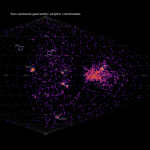Roberto Gorelli points our attention at a recently published meteor related paper.
Meteoroid structure and fragmentation
This paper will be published in Planetary and Space Science by M. D. Campbell-Brown.
Abstract: The physical composition and structure of meteoroids gives us insight into the formation processes of their parent asteroids and comets. The strength of and fundamental grain sizes in meteoroids tell us about the environment in which small solar system bodies formed, and the processes which built up these basic planetary building blocks. The structure of meteorites can be studied directly, but the set of objects which survive entry through the atmosphere is biased toward large, strong objects with slow encounter speeds.
Fragile objects, small objects and objects with high relative speeds are very unlikely to survive impact with the atmosphere. Objects between 100 microns and 1 meter, which are not strong enough to survive the ablation process, must be studied by radar or optical methods.
Large meteoroids, which produce bright fireballs, are generally studied by investigating their compressive strength when they fragment, and their strength can also be inferred indirectly from their end heights.
Fragmentation in faint meteors can be inferred from interference in radar observations, or observed directly with high-resolution optical systems. Meteor light curves, begin heights and time-evolving spectra can also be used to infer meteoroid structure.
This paper presents a review of the meteor observation methods currently used to infer the structure and fragmentation of meteoroids in the millimeter to meter size range, and the current state of understanding these observations have given us.
You can download this paper for free: https://arxiv.org/pdf/1903.06572.pdf (30 pages).
Older meteor library news:
2019
- Solar cycle variation in radar meteor rates, by M. D. Campbell-Brown. (26 February 2019).
- A New Meteoroid Model, by Valeri V. Dikarev, Eberhard Grün, William J. Baggaley, David P. Galligan, Markus Landgraf, Rüdiger Jehn. (12 February 2019).
- Lunar impacts, by Costantino Sigismondi. (12 February 2019).
- Lunar impact flashes, by C. Avdellidou and J. Vaubaillon. (10 February 2019).
- The Geminid parent body: (3200) Phaethon, by Patrick A. Taylor, Edgard G. Rivera-Valentín, Lance A.M. Benner, Sean E. Marshall, Anne K. Virkki, Flaviane C.F. Venditti, Luisa F. Zambrano-Marin, Sriram S. Bhiravarasu, Betzaida Aponte-Hernandez, Carolina Rodriguez Sanchez-Vahamonde and Jon D. Giorgini. (10 February 2019).
- Sun approaching asteroids and meteor streams, by Quanzhi Ye and Mikael Granvik. (10 February 2019).
2018
- Waiting to make an impact: A probable excess of near-Earth asteroids in 2018 LA-like orbits, by C. de la Fuente Marcos and R. de la Fuente Marcos. (18 December 2018).
- What mechanisms dominate the activity of Geminid Parent (3200) Phaethon?, by LiangLiang Yu, Wing-Huen Ip and Tilman Spohn. (6 November 2018).
- The Draconid meteoroid stream 2018: prospects for satellite impact detection, by Auriane Egal, Paul Wiegert, Peter G. Brown, Danielle E. Moser, Althea V. Moorhead and William J. Cooke (21 September 2018).
- Modeling the measurement accuracy of pre-atmosphere velocities of meteoroids, by Denis Vida, Peter G. Brown and Margaret Campbell-Brown (15 July 2018).
2017
- The Mayas and Eta Aquariids in AD 250-909, by J.H. Kinsman and D.J. Asher (31 July 2017).





We were in Costa Teguise, Lanzarote, on eve of March 21st photographing the Wolf Supermoon. I had taken a photo of my husband with his back to the moon which was showing a very bright reflection on the sea. I had just put the camera down when a very bright yellow, meteor , (sorry, don’t know correct word), shot down to the right of the moon and fizzled out before it would have gone into the sea. I shouted to my husband who turned round to catch the tail end. Quite a shock. Did anyone else report seeing this?